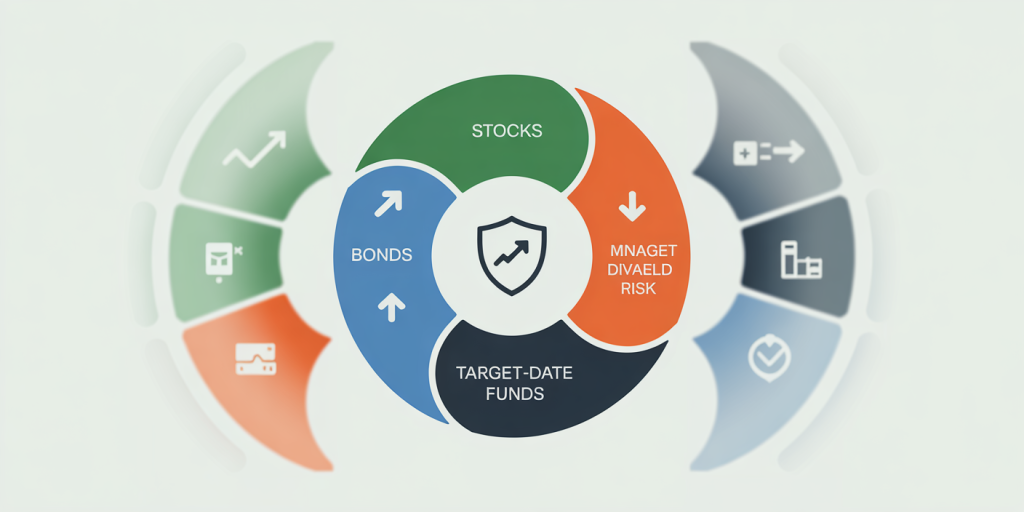Navigating Retirement Savings: A Guide for Late Starters
Anúncios
In today’s fast-paced world, many individuals find themselves unable to begin saving for retirement early on. Whether due to financial struggles, career changes, or unexpected life events, delaying retirement savings is a common concern. However, it’s never too late to develop a robust retirement plan. This guide offers practical insights and strategies to help late starters navigate their retirement savings journey effectively.

Understanding the Challenges of Late Retirement Saving
Anúncios
Starting retirement savings later in life poses unique challenges, primarily due to the loss of the critical advantage of time. The power of compounding interest significantly benefits those who start early, but even late starters can still harness its effects by adjusting their strategies. According to Vanguard’s 2023 “How America Saves” report, the average retirement savings for individuals aged 55-64 is approximately $176,000, whereas for those aged 35-44, it is $69,000. This gap illustrates the compounding advantage of early saving.
Passivity can be costly. If a person begins saving at age 40 instead of 25, they lose 15 years of compounding growth. To illustrate, a $10,000 investment with 7% annual returns grows to about $76,122 in 30 years, but only about $29,457 in 15 years. Despite this, late savers can still catch up by making informed decisions that maximize their contributions and returns.
Anúncios
Maximizing Contributions and Catch-Up Savings
One of the most effective strategies for late starters is to maximize contributions to retirement accounts, especially catch-up contributions. Many retirement plans, including 401(k)s and IRAs, allow individuals over 50 to contribute additional amounts beyond standard limits. For example, in 2024, the 401(k) annual contribution limit is $23,000 for those aged 50 and above, compared to $22,500 for those under 50. Similarly, Traditional and Roth IRAs allow an extra $1,000 catch-up contribution for those 50 and older.
Consider the case of Linda, who started contributing to a 401(k) at age 50. She contributed the maximum annual amount including catch-up contributions and leveraged employer matching. Over 15 years, her disciplined approach allowed her to amass a $400,000 nest egg by age 65, significantly improving her retirement readiness.
Employers offering matching contributions are valuable allies in this equation. According to the Plan Sponsor Council of America, companies typically match 50 cents on the dollar up to 6% of an employee’s salary. Ignoring this benefit means leaving free money on the table. Therefore, late savers should aim to contribute at least enough to earn full employer matching.
The following table demonstrates the impact of maximizing contributions with and without employer match over 15 years (assuming a 7% annual return):
| Contribution Scenario | Total Contributions | Employer Match | Estimated Value at Retirement |
|---|---|---|---|
| Max contributions with employer match | $450,000 | $90,000 | $900,000 |
| Max contributions without employer match | $450,000 | $0 | $730,000 |
| Partial contributions (half max) with match | $225,000 | $45,000 | $460,000 |
Choosing the Right Investment Strategy
Late starters must carefully manage investment risk and growth potential to optimize returns. While younger investors often opt for aggressive portfolios, late starters face a different calculus. They need a balance between growth to catch up and preservation to avoid significant losses.
Diversification is key. A portfolio weighted towards equities can generate higher returns; however, volatility can be challenging near retirement. Using a target-date retirement fund customized to one’s estimated retirement year may be beneficial. These funds gradually adjust asset allocation to become more conservative as retirement nears.
For example, Mark, aged 55, chose a target-date fund aimed at 2030, balancing 65% stocks and 35% bonds. Despite market fluctuations, this diversified approach helped him grow his portfolio steadily without excessive risk exposure. Studies by Morningstar indicate that target-date funds typically yield 6-8% annual returns historically, suitable for late savers seeking moderate growth.

Additionally, alternative investments like real estate investment trusts (REITs) or dividend-paying stocks can supplement income potential. However, late starters should avoid speculative investments with high volatility. Consulting a financial advisor to tailor an investment plan based on risk tolerance and time horizon is strongly recommended.
Leveraging Social Security and Retirement Accounts
Social Security benefits remain a crucial pillar for late starters, particularly if savings are insufficient. Knowing when to claim Social Security is a vital strategy. Delaying benefits until age 70 increases monthly payments; according to the Social Security Administration, delayed claiming can increase monthly benefits by up to 8% annually after full retirement age.

Consider Sarah, who delayed Social Security claiming from 62 to 70, increasing her benefit from $1,200 to $1,900 monthly. This strategy provided a steady income stream enhancing her financial stability during retirement.
In tandem, withdrawing retirement account funds efficiently impacts long-term sustainability. Employing strategies like the “4% rule”—withdrawing no more than 4% of retirement assets annually—helps maintain portfolio longevity.
Furthermore, Roth IRAs offer tax-free withdrawals if used properly, which may be ideal for late starters expecting higher taxes in retirement. Converting Traditional IRAs into Roth IRAs gradually can optimize tax situations, although this requires careful planning.
Avoiding Common Pitfalls and Managing Debt
Late starters are often burdened with outstanding debts such as mortgages, credit card balances, or medical expenses. Carrying high-interest debt into retirement can erode savings and create financial stress. Prioritizing debt reduction alongside retirement saving is crucial.
A typical pitfall observed by financial planners is trying to “do it all” in the final years before retirement by increasing savings exponentially without addressing debt. This can lead to a precarious financial situation if unexpected expenses occur.
For instance, James, age 58, aggressively saved for retirement but neglected his credit card debt with an 18% interest rate. Despite his significant nest egg, his cash flow was constrained by monthly debt payments, forcing him to tap into retirement funds early and incur penalties.
Creating a balanced plan that cuts discretionary expenses, pays down high-interest debts, and steadily saves will strengthen financial resilience.
A Look Ahead: Adapting Retirement Plans for the Future
Future retirees must adapt to evolving economic landscapes and demographic trends. The typical retirement age is shifting later, with more Americans working into their late 60s and beyond (U.S. Bureau of Labor Statistics, 2023). This trend can be advantageous for late starters by extending earning and saving years.
Longevity risk is also a growing concern. With average life expectancy rising, retirement savings need to cover a longer period, increasing the importance of sustainable withdrawal strategies and healthcare planning.
Technological advances provide fresh opportunities. Robo-advisors and automated investment platforms offer low-cost, tailored portfolio management, making sophisticated investment strategies accessible. For late starters juggling multiple priorities, these tools can optimize investment decisions without excessive time commitment.
Government policy changes, including evolving tax laws and potential Social Security reforms, could impact retirement planning. Staying informed and flexible will help savers adjust their approaches as needed.
Ultimately, late starters must treat retirement saving as a dynamic, personalized endeavor. By maximizing contributions, adopting prudent investments, managing debt, and planning for longevity, they can build a secure retirement foundation—even with a delayed start.



Post Comment